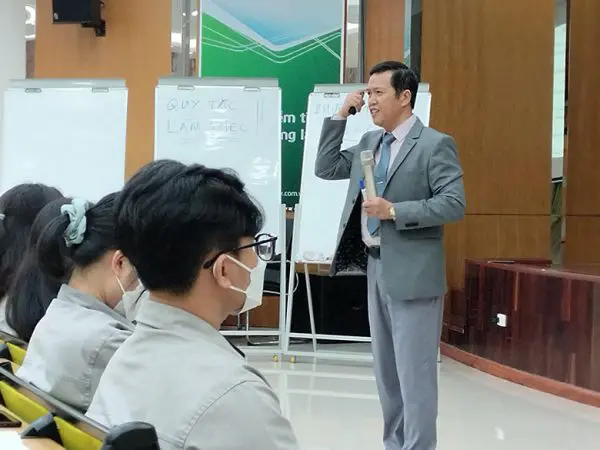|
|
Bộ Công Cụ Làm Việc Với Người Khó Tính
(Dealing with Difficult People Toolkits)

1. Giới thiệu bộ toolkits:
Bộ công cụ Dealing with Difficult People Toolkits được thiết kế nhằm giúp nhân
viên, quản lý và lãnh đạo trong doanh nghiệp hiểu rõ các kiểu hành vi khó xử lý,
tăng khả năng kiểm soát cảm xúc, giao tiếp hiệu quả và giải quyết xung đột một
cách chuyên nghiệp. Bộ công cụ này cung cấp các biểu mẫu, hướng dẫn và kế hoạch
hành động giúp giảm thiểu mâu thuẫn, xây dựng môi trường làm việc tôn trọng, hợp
tác và hiệu quả.
2. Đối tượng sử dụng:
- Nhân viên văn phòng, bộ phận chăm sóc khách hàng, bán hàng hoặc kỹ thuật
thường xuyên tiếp xúc với người khó tính.
- Quản lý nhóm, giám sát viên và trưởng phòng phụ trách đội ngũ nhân viên đa
dạng tính cách.
- Bộ phận nhân sự, đào tạo và phát triển năng lực hành vi.
- Các lãnh đạo doanh nghiệp mong muốn xây dựng văn hóa giao tiếp tích cực và tôn
trọng.
3. Nội dung bộ toolkits:
Part 1. Understanding Human Behavior & Personality Types
Objective: To help employees and managers understand different personality
types and behavioral patterns that can lead to workplace difficulties.
1. DDP-0101_Personality_Type_Assessment_Form.xlsx
2. DDP-0102_Behavioral_Style_Analysis.docx
3. DDP-0103_Typical_Difficult_Person_Profile_Catalog.docx
4. DDP-0104_Emotional_Triggers_Identification_Sheet.xlsx
5. DDP-0105_Self_Assessment_on_Interpersonal_Challenges.docx
6. DDP-0106_Communication_Style_Checklist.docx
7. DDP-0107_Employee_Interaction_Pattern_Log.xlsx
Part 2. Emotional Intelligence & Self-Management
Objective: To develop self-awareness, emotional control, and resilience when
dealing with challenging people or stressful workplace interactions.
1. DDP-0201_Emotional_Intelligence_Self_Assessment.docx
2. DDP-0202_Stress_Management_Techniques_Guide.docx
3. DDP-0203_Emotional_Trigger_Log.xlsx
4. DDP-0204_Calm_Response_Planning_Tool.docx
5. DDP-0205_Mindfulness_Practice_Schedule.xlsx
6. DDP-0206_Self_Control_Action_Plan.docx
7. DDP-0207_Reflection_and_Emotional_Recovery_Log.xlsx
Part 3. Communication & Active Listening Techniques
Objective: To strengthen assertive communication, active listening, and
empathy in order to reduce misunderstandings and tension in difficult
conversations.
1. DDP-0301_Active_Listening_Checklist.docx
2. DDP-0302_Assertive_Communication_Guide.docx
3. DDP-0303_FEEL_Model_for_Difficult_Conversations.docx
4. DDP-0304_Conflict_Conversation_Script_Template.docx
5. DDP-0305_Feedback_Communication_Plan.xlsx
6. DDP-0306_Nonverbal_Communication_Cue_Guide.docx
7. DDP-0307_Empathy_Building_Worksheet.docx
Part 4. Identifying and Managing Difficult Behavior
Objective: To recognize common difficult behaviors, their root causes, and
strategies to handle them effectively and professionally.
1. DDP-0401_Difficult_Behavior_Types_Catalog.docx
2. DDP-0402_Behavior_Impact_Analysis.xlsx
3. DDP-0403_Behavior_Observation_Form.docx
4. DDP-0404_Response_Strategy_Guide.docx
5. DDP-0405_Intervention_Action_Log.xlsx
6. DDP-0406_Pattern_Tracking_Report.xlsx
7. DDP-0407_Difficult_Situation_Case_Study_Template.docx
Part 5. Conflict Management & Resolution Strategies
Objective: To equip employees and managers with structured methods for
resolving conflicts constructively and maintaining collaboration.
1. DDP-0501_Conflict_Assessment_Form.xlsx
2. DDP-0502_Conflict_Resolution_Process_Map.docx
3. DDP-0503_Interest_vs_Position_Analysis.xlsx
4. DDP-0504_WinWin_Resolution_Plan.docx
5. DDP-0505_Mediation_Session_Log.xlsx
6. DDP-0506_Post_Conflict_FollowUp_Report.docx
7. DDP-0507_Team_Conflict_Prevention_Checklist.docx
Part 6. De-escalation & Crisis Communication Techniques
Objective: To provide structured tools for diffusing tense situations and
communicating effectively during emotional or crisis interactions.
1. DDP-0601_Deescalation_Steps_Checklist.docx
2. DDP-0602_Crisis_Communication_Script.docx
3. DDP-0603_Emergency_Response_Protocol_for_Tense_Situations.xlsx
4. DDP-0604_Incident_Response_Log.xlsx
5. DDP-0605_Escalation_Matrix_for_Behavioral_Issues.xlsx
6. DDP-0606_Post_Incident_Review_Report.docx
Part 7. Coaching Difficult Employees
Objective: To train managers and supervisors on how to coach underperforming
or difficult team members toward behavioral improvement.
1. DDP-0701_Coaching_Preparation_Form.docx
2. DDP-0702_Behavioral_Coaching_Session_Template.docx
3. DDP-0703_Coaching_Progress_Tracker.xlsx
4. DDP-0704_Employee_Commitment_Agreement_Form.docx
5. DDP-0705_Coaching_Effectiveness_Evaluation.xlsx
6. DDP-0706_FollowUp_Action_Log.xlsx
Part 8. Building a Positive and Respectful Workplace Culture
Objective: To create an environment that prevents difficult behaviors through
empathy, collaboration, and psychological safety.
1. DDP-0801_Respectful_Workplace_Policy_Template.docx
2. DDP-0802_Workplace_Culture_Assessment_Form.xlsx
3. DDP-0803_Team_Collaboration_Checklist.docx
4. DDP-0804_Employee_Recognition_Log.xlsx
5. DDP-0805_Positive_Communication_Guidelines.docx
6. DDP-0806_Culture_Improvement_Action_Plan.xlsx
Part 9. Feedback, Evaluation & Continuous Improvement
Objective: To evaluate progress, gather feedback, and continually improve
interpersonal and conflict management skills.
1. DDP-0901_Employee_Feedback_Survey.xlsx
2. DDP-0902_Conflict_Resolution_Effectiveness_Report.docx
3. DDP-0903_Self_Evaluation_Form.docx
4. DDP-0904_Peer_Feedback_Tracker.xlsx
5. DDP-0905_Improvement_Action_Tracker.xlsx
6. DDP-0906_Annual_Interpersonal_Skills_Review.docx
Part 10. Managerial Tools for HR & Organizational Support
Objective: To equip HR and management with tools to monitor behavioral
trends, support employee relations, and ensure fairness.
1. DDP-1001_Behavioral_Incident_Report_Form.docx
2. DDP-1002_HR_Intervention_Log.xlsx
3. DDP-1003_Employee_Behavior_Trend_Analysis.xlsx
4. DDP-1004_Managerial_Action_Plan_for_Difficult_Situations.docx
5. DDP-1005_Organizational_Behavior_Audit_Checklist.docx
6. DDP-1006_Employee_Assistance_Program_Tracker.xlsx
7. DDP-1007_Annual_Behavioral_Risk_Report.docx
4. Nguyên tắc sử dụng:
- Mỗi biểu mẫu được thiết kế linh hoạt, có thể áp dụng độc lập hoặc kết hợp
trong quá trình quản lý con người và xử lý tình huống.
- File định dạng .docx được dùng cho hướng dẫn, báo cáo, mô tả quy trình, và
biểu mẫu huấn luyện.
- File định dạng .xlsx được dùng cho theo dõi hành vi, phân tích dữ liệu, đánh
giá và lập kế hoạch hành động.
- Các biểu mẫu nên được cập nhật và điều chỉnh phù hợp với văn hóa và quy mô
doanh nghiệp.
5. Hướng dẫn triển khai trong doanh nghiệp:
- Bước 1: Xây dựng nhóm triển khai (HR, quản lý cấp trung, đào tạo nội bộ).
- Bước 2: Tổ chức workshop giúp nhân viên nhận diện các kiểu người khó tính và
phản ứng phù hợp.
- Bước 3: Huấn luyện kỹ năng quản lý cảm xúc, giao tiếp và giải quyết xung đột.
- Bước 4: Áp dụng các template theo từng tình huống thực tế trong môi trường làm
việc.
- Bước 5: Thu thập phản hồi, theo dõi tiến độ cải thiện và cập nhật các công cụ
định kỳ.
6. Kết quả mong đợi sau áp dụng:
- Giảm thiểu mâu thuẫn, xung đột và hành vi tiêu cực trong môi trường làm việc.
- Tăng khả năng giao tiếp, lắng nghe, và thấu hiểu giữa các cá nhân.
- Phát triển đội ngũ nhân viên tự tin, bình tĩnh và có khả năng xử lý tình huống
khó khăn.
- Xây dựng văn hóa doanh nghiệp tôn trọng, hợp tác và hỗ trợ lẫn nhau.
- Cải thiện hiệu quả quản lý nhân sự và chất lượng dịch vụ khách hàng.
- Góp phần tạo môi trường làm việc an toàn, tích cực và gắn kết hơn trong toàn
tổ chức.

 Translate
Translate











